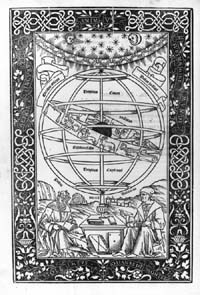Regiomontanus
 Frontispiece of Regiomontanus' Epitome of the Almagest depicting Ptolemy and Regiomontanus sitting beneath an armillary sphere.
Frontispiece of Regiomontanus' Epitome of the Almagest depicting Ptolemy and Regiomontanus sitting beneath an armillary sphere.
Image by kind permission of the Master and Fellows of Trinity College Cambridge.
Johannes Müller von Königsberg, called Regiomontanus, was arguably the most important astronomer of the fifteenth century. Born in the Franconian town of Königsberg in 1436, he was educated at the Universities of Leipzig and Vienna, and appointed to the Arts Faculty of the latter institution in 1457. Georg Peurbach or Peuerbach (1423-1461), Regiomontanus' astronomical mentor, was also a Master at Vienna, and the two men collaborated by, among other things, making observations together. On his deathbed, Peurbach charged Regiomontanus with completing an abridgement of Ptolemy's Syntaxis he had begun at the behest of Cardinal Johannes Bessarion. This work was finished by 1463, and printed as the Epitome of the Almagest in 1496; it was later used by such astronomers as Copernicus and Galileo.
In Vienna, Regiomontanus had been an avid hunter, copyist, and reader of manuscripts on mathematical and astronomical subjects. After Peurbach's death, he went with Bessarion to Rome, and accompanied him on various travels around Italy. Association with the Cardinal, a native of Trebizond in Turkey and a great patron of humanist scholarship, gave Regiomontanus access to other texts, and the opportunity for him to become fluent in Greek. On several occasions, he was to forcefully express his opinion about the inadequacy of translations of Greek works, including Ptolemy's Syntaxis and Geographia. While in Bessarion's service, Regiomontanus constructed an astrolabe, composed works on trigonometry and the armillary sphere, lectured on the Islamic scholar al-Fargãnî at the University of Padua, wrote a critique of the Theorica Planetarum attributed to Gerard of Cremona, and continued to make his own observations. A letter from this period, sent to the astronomer Giovanni Bianchini (d. after 1468), contains Regiomontanus' analysis of all the ways in which current astronomical theory disagreed with the observed phenomena, and expressed the hope, repeated elsewhere, of a collaborative effort to restore the discipline. It is often said, and justly, that Regiomontanus set the agenda for the reform of astronomy to which Copernicus, Tycho Brahe and Kepler all contributed.
Between 1467 and 1471, Regiomontanus worked in Hungary. With some help from the Hungarian court astronomer Martin Bylica (1433-1493), he compiled various astronomical and trigonometrical tables. He also wrote treatises about and constructed instruments for King Matthias and the Archbishop of Gran. In 1471, he relocated to Nuremberg, with the express intention of pursuing the observational reform of astronomy. An important part of his program was the publication of accurate editions of new and ancient texts, for which he obtained his own printing press. But in 1476, before much of his planned work could be completed, he died during a trip to Rome.